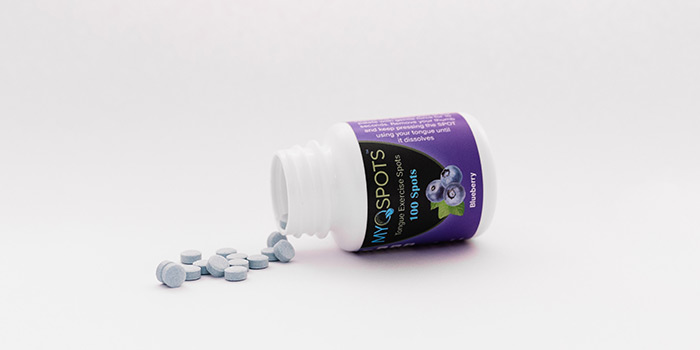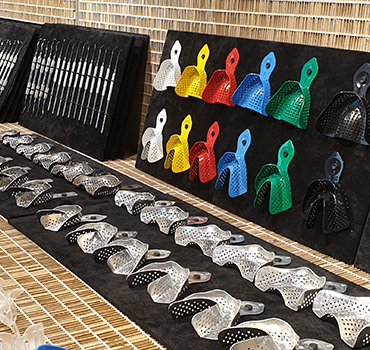Dental Plus Becomes Distributor for MYOSPOTS
The Dental Plus team is excited to announce that we are now an official distributor of MYOSPOTS™. Myospots is a patented Australian technology of biodegradable spots. These spots aim to exercise tongue muscles and to train the tongue to rest on the palate to initiate nasal breathing.
The founders developed the product in 2018 looking to establish a new and simple technology to train chronic-mouth breathers to initiate and maintain healthy tongue posture and nasal breathing.
Today, you can buy MYOSPOTS™ from Dental Plus on the Australian market. In addition, MYOSPOTS™ already exports the product to customers in various international markets.
What does Myospots mean?
The brand name MYOSPOTS™ describes the product and the concept behind it. The Prefix MYO- refers to the muscles (in this case; the tongue and other oral muscles) the product aims to train for habitual tongue elevation. In addition, the suffix -SPOTS describes the product itself. It consists of small, solid, adhesive spots that adhere easily to the roof of the mouth to induce tongue exercise.
How do Myospots work?
Myospots are specifically designed to stick to the hard palate (just behind the two front teeth). Once adhered, the Myospot guides the tongue to elevate and touch it until it is completely dissolved. Each Myospot provides about 50 minutes to an hour of tongue raising training. Using Myospots two to three times a day for three to six months can create a habitual tongue raising posture in addition to tongue exercises to increase tongue muscle tone.
This facilitated tongue exercise is important to create the habit of nasal breathing. It also contributes to increase tongue muscle tone in cases requiring tongue training. This may be the case for people who experience a tongue thrust after the removal of a tongue tie. Another example would be the rehabilitation of post-stroke patients.
Myospots expand and stick to the palate when wet. For this reason, they should not be chewed or swallowed. The spot can adhere to the oesophagus and cause discomfort. If you swallow a spot by accident, try to have a meal. This will create large boluses of food that can help dislodge the spot and push it to the stomach. Children less than 6 years old must use the product only under supervision of adults.
Watch this video to find out more about how to use Myospots:
What is the concept behind Myospots?
Chronic mouth breathing is a public-health issue that is often overlooked. This happens despite its direct link to a range of conditions and health issues. During mouth breathing, the tongue often drops and sits low in the mouth to allow air to flow in and out of the of the oropharynx. On the other hand, an elevated tongue position helps encourage lip seal and nasal breathing.
Research has linked chronic mouth breathing to various health issues such as:
- Snoring1 and sleep apnoea1,2
- Asthma3 and dermatitis4
- Tooth and gum disease5
- Swallowing difficulties6
- Certain dental malocclusions7
- Regression of orthodontic treatment8
- Recurrent infection of tonsils and adenoids9
- Speech disorders9
The prevalence of mouth breathing in children is reported to be 50–56%. Additionally, children with untreated mouth breathing may develop long, narrow faces, narrow mouths, high palatal vaults, dental malocclusion, gummy smiles, and many other unattractive facial features.7
Based on these findings, changing the habit of chronic mouth breathing into nasal breathing may lead to significant improvements in these health conditions.
What are the ingredients of Myospots?
MYOSPOTS AUSTRALIA Pty Ltd developed and owns MYOSPOTS™. A highly reputable pharmaceutical manufacturer in Switzerland (Acino Pharma) manufacturers the spots. Myospots are a Class I medical device and is listed on the ARTG (Australian Register of Therapeutic Goods) under ARTG Entry 326829.
Myospots consist of a mixture of safe biodegradable polymers, namely agar, xanthan gum and cellulose gum. They also contain the sweetener stevia and natural, safe food additives for colouring and flavouring.
Importantly, there is no gluten, soy or dairy products in the composition. Myospots are also free from sugar and gelatine. Therefore, they are suitable for Vegans, Halal and Kosher users.
Where can I buy Myospots?
Both blueberry and banana flavours are now available in the Dental Plus Online Shop. They are the first products of the myofunctional product range that Dental Plus offers.
References
1 de Felício CM, da Silva Dias FV, Trawitzki LVV. Obstructive sleep apnea: focus on myofunctional therapy. Nat Sci Sleep. 2018;10:271-286 https://doi.org/10.2147/NSS.S141132 (27/08/2020)
2 Adel Bachour, Paula Maasilta. Mouth Breathing Compromises Adherence to Nasal Continuous Positive Airway Pressure Therapy. CHEST. Elsevier. October 2004; 126; 1248 https://doi.org/10.1378/chest.126.4.1248 (27/08/2020)
3 Izuhara Y, Matsumoto H, Nagasaki T, et al. Mouth breathing, another risk factor for asthma: the Nagahama Study. Allergy. 2016;71(7):1031-1036. doi:10.1111/all.12885 (27/08/2020)
4 PLoS One. 2015; 10(4): e0125916. Published online 2015 Apr 27. doi: 10.1371/journal.pone.0125916 (27/08/2020)
5 Choi JE, Waddell JN, Lyons KM, Kieser JA. Intraoral pH and temperature during sleep with and without mouth breathing. J Oral Rehabil. 2016;43(5):356-363. doi:10.1111/joor.12372 (27/08/2020)
6 Miho Nagaiwa, Kaori Gunjigake, Kazunori Yamaguchi; The effect of mouth breathing on chewing efficiency. Angle Orthod 1 March 2016; 86 (2): 227–234. doi: https://doi.org/10.2319/020115-80.1 (27/08/2020)
7 Grippaudo C, Paolantonio EG, Antonini G, Saulle R, La Torre G, Deli R. Association between oral habits, mouth breathing and malocclusion. Associazione fra abitudini viziate, respirazione orale e malocclusione. Acta Otorhinolaryngol Ital. 2016;36(5):386-394. doi:10.14639/0392-100X-7708 Eur J Orthod. 2016; 38(3); 227 (27/08/2020)
8 Kukwa W, Guilleminault C, Tomaszewska M, Kukwa A, Krzeski A, Migacz E. Prevalence of upper respiratory tract infections in habitually snoring and mouth breathing children. Int J Pediatr Otorhinolaryngol. 2018;107:37-41. doi:10.1016/j.ijporl.2018.01.022 (27/08/2020)
9 Potter NL, Nievergelt Y, VanDam M. Tongue Potter NL, Nievergelt Y, VanDam M. Tongue Strength in Children With and Without Speech Sound Disorders. Am J Speech Lang Pathol. 2019;28(2):612-622. doi:10.1044/2018_AJSLP-18-0023Strength in Children With and Without Speech Sound Disorders. Am J Speech Lang Pathol. 2019;28(2):612-622. doi:10.1044/2018_AJSLP-18-0023 (27/08/2020)



